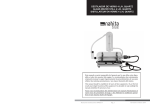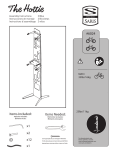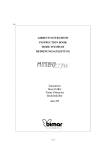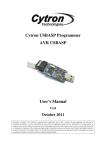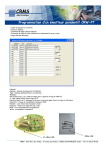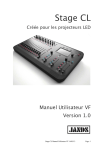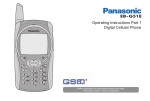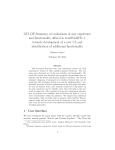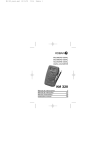Download Shirley Wong - School of Engineering Science
Transcript
School of Engineering Science • Burnaby, BC • V5A 1S6 http://ssi.cjb.net • [email protected] February 16, 1999 Dr. Andrew Rawicz School of Engineering Science Simon Fraser University Burnaby, BC V5A 1S6 Re: ENSC 370 Project MAPSS Functional Specifications Dear Dr. Rawicz: The attached document, MAPSS (Mobile Alarm Paging Security System) Functional Specification, outlines the requirements of our ENSC 370 project. Our goal is to design and implement an automobile feedback information center. The device alerts the car owner in the occurrence of a car alarm, the activation of the ignition system, and if the headlights have been left on. The module shall deliver a unique mobile page for each such event. This document highlights the desired functionality of the entire system, and the specifications of the various components within the system. The functional components include the sensor input and decoding unit, page encoding and dialing unit, and the programmable user interface unit. Smart Sense Innovations consists of four motivated, innovative, and talented third-year engineering students - May Huang, Shirley Wong, Caroline Dayyani, and Frederick Ghahramani. If you have any questions or concerns about this document, Please feel free to contact me by phone at (604) 941-0629 or by e-mail. Sincerely, Shirley Wong Shirley Wong President and CEO Smart Sense Innovations Enclosure: MAPSS Functional Specification Functional Specification for a Mobile Alarm Paging Security System Project team: Caroline Dayyani Frederick Ghahramani May Huang Shirley Wong Contact Personnel: Frederick Ghahramani [email protected] Submitted to: Issued date: Revision: Dr.Andrew Rawicz – ENSC 370 Steve Whitmore – ENSC 305 School of Engineering Science Simon Fraser University February 16, 1999 1.0 Mobile Alarm Paging Security System Functional Specification EXECUTIVE SUMMARY Your car was stolen. What do you do? CALL THE POLICE! Your car’s gone!! They’ll catch the crooks, like they always do on television. First they’ll put out an all point’s bulletin, then find your car and fingerprint it for leads to find the punks…wishful thinking. Provincial auto-crime has increased 750% in the past decade. This staggering statistic has led to the inability of law-enforcement officials to ‘chase the crooks’. In most circumstances when the exact timing of the auto-crime is unknown, the police record the theft claim and description of the car for insurance purposes. No investigation, no fingerprints, no car chases. This predicament has forced consumers to purchase anti-theft systems to better safeguard their automobile investments. However traditional car alarm systems are unreliable, annoying, persistently going off, and provide little feedback to the car owner as to the state of the car. Smart Sense Innovations is now developing the next generation of alarm systems. This new product informs the car owner, through a mobile page, of the state of various systems in the car. The device known as MAPSS, is a micro-controller and mobile telephone based apparatus. Sensors are attached to the car security system, the car ignition system, and the car headlights. Upon activation, the module senses if the car alarm has been activated, or if the headlights have been left on, or if the car is turned on. The device then pages the car owner accordingly, informing the owner of the specific event. In designing and delivering this product, Smart Sense Innovations is establishing new foundations for car security systems. Gone are the days when car alarms would activate at random in hopes of scaring away criminals. SSI’s next generation of auto-security systems aim to act as an interactive mobile information center: constantly feeding back vital statistics about the state of the car to it’s owner. This document introduces the various functional components of the MAPSS system, outlining the product’s different operating stages and states. Some potential future improvements and feature adjustments are also discussed. Copyright 1999, Smart Sense Innovations ii Mobile Alarm Paging Security System Functional Specification TABLE OF CONTENTS Executive Summary ........................................................................................................................ ii Table of Contents........................................................................................................................... iii Introduction.....................................................................................................................................1 System Overview ..............................................................................................................................2 Programmable User Interface .........................................................................................................4 Sensory Input and Decoding Unit....................................................................................................5 a) Signal Acquisition................................................................................................................................6 b) Signal Conditioning.............................................................................................................................7 c) Actuator Interface ................................................................................................................................7 Page Encoding and Dialing Unit.....................................................................................................8 Physical Requirements.....................................................................................................................9 Environmental Requirements ..........................................................................................................9 Electrical Requirements.................................................................................................................10 Safety Requirements ......................................................................................................................10 a) Enclosure ........................................................................................................................................... 10 b) Electrical Isolation ............................................................................................................................ 10 c) Emission ............................................................................................................................................ 10 Reliability Requirements................................................................................................................11 a) Accuracy .............................................................................................................................................11 b) Durability............................................................................................................................................11 Standards .......................................................................................................................................12 Training.........................................................................................................................................12 Potential System Limitations .........................................................................................................12 Conclusion.....................................................................................................................................13 Copyright 1999, Smart Sense Innovations iii Mobile Alarm Paging Security System Functional Specification INTRODUCTION Car owners have several options in attempting to counter the recent rise in auto theft and vandalism. Many third-party after market systems have been developed and marketed. These products range from physical preventative devices that lock the steering wheel, to alarm driven deterrent systems that sound a siren alerting passersby of illegal activity. However traditional anti-theft alarm based systems are unreliable, annoying, persistently going off and provide little feedback to the car owner as to the state of the car. MAPSS aims to address this shortcoming in current auto-security systems by incorporating a telephony device into the system. The inclusion of a communication framework between the car and its owner serves to best inform the owner of the current conditions of the car. MAPSS is a standalone programmable module that monitors the state of the car security system, the ignition system, and the car’s headlights. Upon sensing input from the various car subsystems, MAPSS encodes and delivers a unique mobile page to the car owner. This page is displayed in an alphanumeric representation, thus informing the car owner in plain English of the state of the car. The purpose of this document is to describe the functional requirements of the MAPSS device, and to resolve Smart Sense Innovations’ April 1999 deliverables. The intended audience for this document is Dr. Andrew Rawicz, Mr. Steve Whitmore, the design engineers of Smart Sense Innovations, and various external third party design consultants. Copyright 1999, Smart Sense Innovations 1 Mobile Alarm Paging Security System Functional Specification SYSTEM OVERVIEW The MAPSS system will obtain input from the car security, ignition, and headlight systems, and generate an output in the forms of an encoded mobile page. Figure 1 shows the system context diagram. The figure illustrates that the device will remain in a “busy loop” until an input signal triggers the system to encode and deliver a page. At which point the system returns to the “busy loop”. MAPSS Input Signal Car Owner Figure 1: System Context Diagram Figure 2 demonstrates the MAPSS system block diagram. A more in-depth functional decomposition of each sub-block is discussed in the subsequent sections. Car Input Signal Sensory Input and Decoding Page Encoding and Dialling Programmable User Interface Figure 2: System Block Diagram Copyright 1999, Smart Sense Innovations 2 Page Delivered to Car Owner Mobile Alarm Paging Security System Functional Specification The above functional blocks will combine to satisfy the following system functional requirements. The MAPSS system shall: Ø Ø Ø Ø Ø Interface with the existing car security system, car ignition system, and the car’s headlights. Provide an LCD display screen and keypad for the user to program the desired pager number Utilize the existing car battery for a power supply. Have a power switch for the user to enable/disable the system Have a response time of no more than 45 seconds; the response time for this system is the time required for the system to process the input from the car’s subsystems and generate and deliver a mobile page. Ø Deliver unique alphanumeric pages for each of the 3 sensory inputs. Ø Be encompassed in a non-descript black box for ideal stealth integration into any car security system. Copyright 1999, Smart Sense Innovations 3 Mobile Alarm Paging Security System Functional Specification PROGRAMMABLE USER INTERFACE The first stage of the MAPSS system is responsible for interfacing with the user. In specific, this stage is responsible for obtaining and storing the telephone number, which will be called at the output stage. Figure 3 demonstrates the context with which this stage fits into the entire MAPSS system. Sensory Input and Decoding Car Input Signal Page Encoding and Dialling Page Delivered to Car Owner Programmable User Interface Figure 3: Programmable User Interface Context Diagram Figure 4 demonstrates the Programmable User Interface functional diagram. The User Interface module consists of the input process and visual output display. The input is entered using a keypad. (e.g. telephone keypad) The output is displayed on an alphanumeric LCD screen. The screen will also have the capability to display other parameters such as the date, time, and activation duration. Process/Store Signal User keypad input Displays signal via LCD Figure 4: Programmable User Interface Functional Diagram Copyright 1999, Smart Sense Innovations 4 Mobile Alarm Paging Security System Functional Specification SENSORY INPUT AND DECODING UNIT The second stage of the MAPSS system is responsible for sensory input and decoding. In specific, this stage is responsible for acquiring the input signal from the car security, ignition, and headlight systems. Figure 5 demonstrates the context with which this stage fits into the entire MAPSS system. Car Input Signal Sensory Input and Decoding Page Encoding and Dialling Page Delivered to Car Owner Programmable User Interface Figure 5: Sensory Input and Decoding Unit Context Diagram Figure 6 demonstrates the system block diagram for the sensory input and decoding unit. Car Input Signal Input from User Interface Signal Acquisition Signal Conditioning Actuating Interface Enable/ Disable Switch Figure 6: Sensory Input and Decoding Unit Functional Diagram Copyright 1999, Smart Sense Innovations 5 Output to next MAPSS subsystem Mobile Alarm Paging Security System Functional Specification a) Signal Acquisition The first stage of the sensory input and decoding stage is the signal acquisition. The signal coming from the car alarm, car ignition, or the headlights will be fed to one of the three sensors after the user activates the enable/disable switch. Figure 7 demonstrates the functional block diagram for this stage. Alarm Sensor Detector Analogue input signal from the car Headlights Sensor Detector Output signal to signal conditioning Ignition Sensor Detector 3 Figure 7: Functional Block Diagram of Signal Acquisition The sensors used to acquire the input signal for this stage have the following specifications: Ø Ø Ø Ø Ø Ø The required sensor be activated once the user activates the enable/disable switch Able to detect the activation of the car alarm Able to detect the activation of the ignition system Able to detect the state of the car headlights Have a high signal-to-noise ratio Pass the acquired signal to the signal conditioning stage Copyright 1999, Smart Sense Innovations 6 Mobile Alarm Paging Security System Functional Specification b) Signal Conditioning The second stage of the sensory input and decoding unit is signal conditioning. It’s composed of signal amplification and signal filtering. Figure 8 demonstrates the functional block diagram of this stage. Input from signal Acquisition Output to actuator Interface Amplification Stage Filtering Stage Figure 8: Functional Block Diagram of Signal Conditioning The Signal Conditioning unit shall: Ø Ø Ø Ø Ø Receive the required signal from the signal acquisition unit Amplify the signal to the level required by the actuator interface unit Reduce the noise Provide the signal to the actuator interface unit Filter between the 2 types of car alarm activation (impact, non-impact) c) Actuator Interface The last stage of the sensory input and decoding unit is the actuation of the signal. Figure 9 demonstrates the functional block diagram of this stage. Input signal from signal conditioning Actuator Interface Hardware Output to Page Encoding and Dialing unit Figure 9: Functional Block Diagram of Actuator Interface Copyright 1999, Smart Sense Innovations 7 Mobile Alarm Paging Security System Functional Specification The actuator interface will receive the signal from the signal-conditioning unit. Through the use of high-speed comparators and switches, the actuator interface will then interpret the input signal. It will send the output results to the page encoding and dialing unit. PAGE ENCODING AND DIALING UNIT The third stage of the MAPSS system is responsible for interfacing with the telephony device. In specific, this stage is responsible for encoding, composing, and delivering the appropriate mobile page. Figure 10 demonstrates the context with which this stage fits into the entire MAPSS system. Car Input Signal Sensory Input and Decoding Page Encoding and Dialling Programmable User Interface Figure 10: Page Encoding and Dialing Unit Context Diagram Figure 11 demonstrates the functional block diagram for this stage of the system. Figure 11: Page Encoding and Dialing Unit Functional Block Diagram Copyright 1999, Smart Sense Innovations 8 Page Delivered to Car Owner Mobile Alarm Paging Security System Functional Specification Upon the completion of this project, the page encoding and dialing unit will possess the following functionality: Ø Ø Ø Ø Ø Detect input from the User Interface stage and encode the phone number Store this phone number in the Dialing and Telephony interface memory Detect input from the Sensory Input stage and select an appropriate message to encode Store the message in the Dialing and Telephony interface memory Dial into a pager network, sending an alphanumeric page to the owner PHYSICAL REQUIREMENTS The overall enclosure and casing of the MAPSS system will be portable and pose minimal disturbances to the user. The system is intended to be concealed in the trunk of a car, it will be designed to be mounted internally with mounting brackets and screws. Furthermore, the device will be encased to occupy as little of the trunk space as possible. The physical requirements are highlighted in Table 1. Table 1: MAPSS System Physical Requirements Height: Length: Width: Weight: 15 cm maximum 30 cm maximum 20 cm maximum 2.5 kg maximum ENVIRONMENTAL REQUIREMENTS The MAPSS system will meet the environmental requirements listed in Table 2. Table 2: MAPSS System Environmental Requirements Operating Temperature: Shipping Temperature: Heat Dissipation: Humidity: Copyright 1999, Smart Sense Innovations -20C to 60C -30C to 70C Minimal (pW range) Full range of ATM humidity 9 Mobile Alarm Paging Security System Functional Specification ELECTRICAL REQUIREMENTS The MAPSS system will meet the electrical requirements listed in Table 3. Table 3: MAPSS System Electrical Requirements Voltage: Power: 15 V maximum 5 watts maximum SAFETY REQUIREMENTS The MAPSS system will meet the following safety requirements. a) Enclosure The enclosure will not possess sharp corners or edges that would pose a danger to the user. The enclosure will not contain protrusions or odd extensions of any form. b) Electrical Isolation The exterior casing of the system will ensure electrical isolation from the internal circuitry. All sensory inputs will contain output protection circuitry to eliminate risks to the user. All inputs and outputs to the system will be shielded and protected from external static voltage sources. c) Emission The system will not emit or be affected by any form of electromagnetic radiation. The system will not effuse carbon-based emissions, rendering it compliant with the 1997 Kyoto Summit on Global Warming. Copyright 1999, Smart Sense Innovations 10 Mobile Alarm Paging Security System Functional Specification RELIABILITY REQUIREMENTS The MAPSS system will meet the following reliability requirements. a) Accuracy Accuracy and response times are highly dependent on the performance and reliability of the underlying mobile paging and telephone networks. According to 1997 CRTC regulations, wireless service providers must limit their annual “down time” to less than 6 hours. However, this figure does not include the inability to compose a call when the mobile phone is physically outside of the network coverage area. An independent MAPSS system, operating within the coverage range of a functional wireless service will have a response of 90%. This means 9 out of 10 times, the unique page will be encoded correctly, and delivered to the user accordingly. b) Durability The POOPO system will be robust enough to withstand daily use for a minimum of two years. Since the system will be stored and located in a car trunk, it will be designed to withstand the vibrations that exist inside a non-insulated trunk. Copyright 1999, Smart Sense Innovations 11 Mobile Alarm Paging Security System Functional Specification STANDARDS The MAPSS system will comply with UL, CSA, and CE standards. TRAINING The user of the POOPO system will be required to program the telephone number of the pager that will be dialed. For this purpose, a simple manual will be written that will highlight the functionality and usage of the keypad interface. A copy of this manual will also be made available on the World Wide Web for future reference. POTENTIAL SYSTEM LIMITATIONS The MAPSS system will be limited by the following factors: 1) Only one page can be delivered to the car owner at one time. Multiple signals will be cued in a first in first out manner. 2) Only one phone number can be programmed into the user interface module at one time. Subsequently, only one phone number can be dialed. 3) Operation is physically limited to locations of cellular network coverage. Copyright 1999, Smart Sense Innovations 12 Mobile Alarm Paging Security System Functional Specification CONCLUSION This document has discussed the functional considerations of building an operational prototype for a mobile paging car security system. The MAPSS system will be designed based on the functional specifications described in this document. The technology that is applied in the MAPSS system will also serve to act as a fundamental precursor to future feature developments. These could include the addition of a Global Positioning System embedded in the CDMA based mobile telephone. A voice recorded messaging system, and the alteration to allow the user to dial into the car to deactivate the various subsystems. In designing and delivering this product Smart Sense Innovations is establishing new foundations for car security systems. Gone are the days when car alarms would activate at random in hopes of scaring away crooks. SSI’s new generation of auto-security systems aim to act as an interactive mobile information center. Constantly feeding back vital statistics about the state of the car to its owner. Your car was stolen and there’s not much you can do. It could happen again… isn’t it time you purchased a MAPSS? Copyright 1999, Smart Sense Innovations 13 Mobile Paging Car Security System Functional Specification Appendix: User Manual Copyright 1999, Smart Sense Innovations 1 Okay, so I want Mobile Alarm Paging, and I’ve paid my $699.95, so how do I use it ? Alarm Code --1---2-- Mobile Alarm Paging Security System User Manual Ensure you have MAPSS professionally installed, so you can have access to our warranty protection and technical support. Otherwise, if something goes wrong, we’ll just hang up on you. Welcome to a new way of protecting your vehicle. Those wonderful folks at Smart Sense bring you a state-of-the-art car security product like no other. Once the MAPSS unit has settled down and is happily residing in your car, it’s time to put it to work. Operating your MAPSS is as easy as 1-23. What is Mobile Alarm Paging? Directions With ordinary car security systems, an attack on vehicle integrity is announced by a blaring siren, flashing lights, or perhaps a honking horn. This hullaballo is supposed to attract attention to the car, but these days nobody heeds a car alarm. Worse still, what if you’re on a hot date, and you have to go out of earshot of the car? With a conventional alarm system, you have Hobson’s choice: leave your car effectively unprotected (think your neighbour's gonna care about your wheels?) or miss out on maybe the only lovin’ you’ll get that month. The Mobile Alarm Paging Security System (MAPSS) puts an end to these dilemmas by putting security right in your pocket, making sure that the next time you come back to your car, you’ll be happy to see it. MAPSS will even tell you what kind of attack is being made on your car, so you can fully assess the situation. There’s more, too: MAPSS also alerts you when you’ve left your headlights on. After all, there’s no greater mood-killer than having to call a tow truck. 1) 2) 3) Turn on your MAPSS system. The power switch is on the top panel of the MAPSS unit (see figure 1). Wait for your MAPSS system to power up (the green light will come on) and watch for the welcome message on the display screen: “Welcome to MAPSS. Enter pager number.” Enter your pager number using the MAPSS keypad. It will accept 7 digits. When you have typed the last digit, it will display a right arrow at the end of the number (“<-“). You’re done! The MAPSS system is armed and ready. You can leave your car. If an intruder comes by and sets off your alarm, the MAPSS system will instantly dial your pager number and leave you a message. The message will consist of three dashes (which tell you the message is from MAPSS and not from the hottie in the first paragraph) followed by a single digit which tells you why MAPSS is generating an alert (see table). --3-- Meaning Car alarm has been activated Engine has been started Lights are on Figure 1: MAPSS control panel Display Screen On Off Power On Light (Green) SSI MAPSS 1 4 7 * Display Screen Contrast Adjustment 2 5 8 0 3 6 9 # Power Failure Warning Light (Red) Warranty This unit is offered AS IS, and no warranty, expressed or implied (except as required by law) shall be provided. In all cases liability shall be limited to repair or replacement of the MAPSS unit. SMART SENSE INNOVATIONS WILL NOT BE HELD RESPONSIBLE FOR DIRECT OR INDIRECT LOSSES INCURRED AS A RESULT OF USING THIS PRODUCT. Copyright 1999 (and we party like it!) Smart Sense Innovations Text and Design by R & R Productions, a division of Wired Cola Manuel Mobile D'Utilisateur De Système De Sécurité De Pagination D'Alarme Bienvenue à une nouvelle voie de protéger votre véhicule. Ces gens merveilleux au sens futé vous apportent un produit de pointe de degré de sécurité de voiture comme aucun autre. Quelle est pagination mobile d'alarme? Avec les systèmes ordinaires de degré de sécurité de voiture, une attaque sur l'intégrité de véhicule est annoncée par une sirène d' éclatement, des lumières clignotantes, ou peut-être un klaxon cornant. Ce hullaballo est censé pour attirer l'attention à la voiture, mais de nos jours personne n'observe une alarme de voiture. Un plus mauvais distillateur, que si vous êtes unedate chaude, et devez-vous sortir de la distance de la voiture? Avec un système d'alarme conventionnel, vous avez le choix de Hobson: laissez votre voiture pertinemment non protégée (pensez le soin du gonna de votre voisin à vos roues?) ou manque dehors sur peut-être le seul lovin ' vous aurez ce mois. Le système mobile de sécurité de pagination d'alarme (MAPSS) met un terme à ces dilemmes en mettant le juste de sécurité dans votre poche, s'assurant que la prochaine fois que vous revenez à votre voiture, vous serez heureux de la voir. La volonté de MAPSS vous indiquent même que quel genre d'attaque est fait sur votre voiture, ainsi vous pouvez entièrement évaluer la situation. voiture. Si un intrus vient par et Il y a plus, trop: De MAPSS alertes également vous quand vous avez laissé vos phares en fonction. Après tout, il n'y a aucun plus grand humeur-tueur que devant appeler un camion de remorquage. Est-ce qu' ok, ainsi je veux la pagination mobile d'alarme, et j'ont payé mes $699,95, ainsi comment je l'utilise? dernier chiffre, il affichera une flèche droite à la fin du nombre (" <-"). Vous êtes faits! Le système de MAPSS est armé et prépare. Vous pouvez laisser votre place outre de votre alarme, le système de MAPSS immédiatement composera votre numéro de pagineur et vous laissera un message. Le message composer trois tiret (qui dire vous message MAPSS et pas hottie dans premier paragraphe) suivi un simple chiffre quel indiquer vous pourquoi MAPSS produire unalerte (voir table). Assurez-vous ont MAPSS à professionnellement installé, ainsi vous pouvez avoir accès notre protection de garantie et support technique. Autrement, si quelque chose tourne mal, nous raccrocherons juste sur vous. Code --1-- Signification alarme de voiture a été lancé --2-- que le moteur a été Une fois que l'unité de MAPSS s'est fixée et réside heureusement dans votre voiture, il est temps de la mettre pour travailler. Le fonctionnement de votre MAPSS est aussi facile que 1-2-3. --3-- Directions 1) allument votre système de MAPSS. Le commutateur de puissance est sur le panneau supérieur de l'unité de MAPSS (Voir le schéma 1 sur précédente la page). 2) attendent votre système de MAPSS pour mettre (le feu vert avancera) et montre pour le message bienvenu sur l'écran de visualisation: " bienvenue à MAPSS. Écrivez le nombre de pagineur. " 3) écrivent votre nombre de pagineur en utilisant le bloc de touches de MAPSS. Il recevra 7 chiffres. Quand vous avez tapé le démarré lumières sont allumées Garantie Cette unité est offerte COMME EST, et aucune garantie, exprimée ou implicite (excepté selon les exigences de la loi) ne sera fournie. Dans tous les cas la responsabilité sera limitée pour réparer ou remplacement de l'unité de MAPSS. DES INNOVATIONS FUTÉES DE SENS NE SERONT PAS JUGÉES RESPONSABLES DES PERTES DIRECTES OU INDIRECTES ENCOURUES EN RAISON D'CUtiliser CE PRODUIT. Copyright 1999 (et nous la partie l'aiment!) Innovations Futées De Sens Texte et conception de R et productions de R, une division de Câble de Kola






















